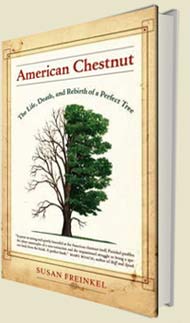Under the Spreading Chestnut Tree
The New York Times, April 30, 2005
To celebrate Arbor Day yesterday, President Bush added a new tree to the White House grounds -- an American chestnut. At first glance it may seem an odd choice, since chestnuts have been largely absent from the American landscape for more than half a century. Yet if any species can help us see the importance of trees to humanity, it is the American chestnut, and its story makes it the perfect emblem for Arbor Day.
Chestnuts were once so plentiful along the East Coast that according to legend a squirrel could travel the chestnut canopy from Georgia to Maine without ever touching the ground. The trees grew tall, fast and straight. Many considered it the perfect tree: it produced nourishing food and a rot-resistant wood that was used for everything from furniture to fence posts. Chestnut ties were the sturdy foundation of the ever-expanding railroad lines; chestnut poles held up the lengthening miles of electrical and telephone wire.
Then in the early 20th century a deadly fungus imported from Japan hit American forests. Within 40 years this fast and merciless fungus spread over some 200 million acres and killed nearly four billion trees. The blight brought the chestnut to the brink of extinction. Even today new sprouts continue to shoot up from the roots of seemingly dead trees only to be attacked again by the fungus before they can flower and reproduce.
But, in memory at least, the tree endures. That's particularly true in Appalachia, where the chestnuts were vital to the local culture and economy. The sweet nuts that appeared every fall sustained people and their livestock. Families built their homes from chestnut logs, marked their property with chestnut fences and brewed home remedies for burns from chestnut leaves.
I recently spent several days in the heart of the tree's historic range: southwest Virginia, where old chestnut rail fences still snake across the land and memories of the tree remain sharp. One 92-year-old man pointed out an empty hillside that once held a grove of chestnut trees. Each fall he collected the small mahogany nuts in a tin bucket for his mother to sell at the general store. Chestnuts paid for school supplies, sugar, shoes -- things they couldn't make for themselves on their farm.
A retired schoolteacher showed me a photograph of the tall chestnut that bordered a field on her family's farm when she was a child -- the ''sentinel'' that meant she was nearing home. The elderly owner of a country store recalled how locals would cart in thousands of pounds of nuts to be hauled on horse-drawn wagons to railroad depots for shipment to cities like Richmond, Boston and New York, where they'd be sold hot and roasted on the streets. The last time he tasted an American chestnut, he said, was from a squirrel's stash he and his little sister dug up on June 7, 1928. The date is etched in memory because his sister died the next day.
Their stories paint a picture of another time -- of dirt roads, log cabins, fragrant haystacks and cool springhouses shaded by majestic trees. Whether the memories draw on direct experience or stories told by parents or grandparents, they are filled with a love and a longing that transcends mere nostalgia.
Chestnut blight showed North Americans just how devastating an invasive species could be to trees. Now with the explosion of global commerce, forests nationwide are battling foreign pests and pathogens. The current patient roster includes white pines, beeches, ashes, butternuts, Eastern hemlocks and Port Orford cedars, as well as the newly designated national tree, the oak.
It is not yet clear whether Americans have the will or a way to preserve the many threatened species of trees that have helped define our communities. But the chestnut, which has inspired valiant efforts to pull it back from the edge of oblivion, suggests we might. The American Chestnut Foundation has been patiently interbreeding the American chestnuts with its blight-resistant Asian cousins to come up with a hybrid that looks like an American chestnut, but fights the fungus Asian-style. The foundation says it hopes to have its first crop of blight-resistant nuts ready by next year for trial plantings in forests. The White House chestnut tree is one of these hybrids.
The United States Forest Service has agreed to work with the foundation to get chestnuts back into the wild. Experts involved hope the project will be a model for saving and restoring other endangered trees. Of course, the best protection for our forests is prevention: stanching the influx of invasives with tighter controls on imported nursery stock and rules like those requiring anti-pest treatment of wood crates and pallets that have carried unwelcome stowaways like the gypsy moth. The more we do to improve the health of our forests -- using controlled fires to clear brush and thin the woods, for instance -- the better trees will be able to withstand any new onslaughts.
There are good economic and environmental reasons for bringing back the chestnut: it's a fast-growing source of good timber, a boon for wildlife and an efficient way to draw carbon and pollutants out of the atmosphere. But many of the people I have met would save the chestnut simply for its own sake, as a welcome companion.
When the blight hit southwest Virginia in the 1920's, the elderly shop owner told me, folks predicted the tree wouldn't be beat. ''They said it would be back in 100 years,'' he recalled. The chestnut probably couldn't have staged a comeback on its own, but thanks to the efforts of a devoted few, chestnuts and people may yet have a future together.
Susan Freinkel is a fellow with the Alicia Patterson Foundation and the author of a forthcoming book on the American chestnut.
